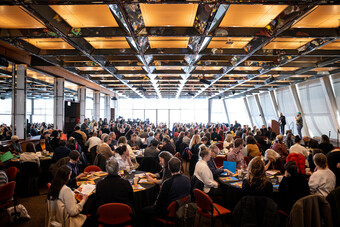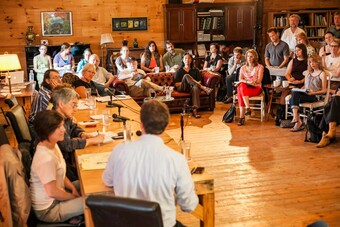Embracing Collective Action as a Means of Survival
This essay is part of a series related to the upcoming National Innovation Summit for Arts & Culture.
Are we facing a period in the arts sector where taking collective action will not only be innovative practice, but essential for the survival of struggling nonprofit arts organizations?
I’ve been thinking about this question in advance of the upcoming National Innovation Summit for Arts & Culture, which will feature six twelve-minute talks on “Taking Collective Action” from arts leaders across the country.
I believe that we’re in an era when most arts communities suffer from an oversaturation of nonprofit arts organizations vying for an audience’s time, attention and, most of all, their money. With each organization touting its merits, it has become increasingly difficult to distinguish one from the other especially, I would imagine, for donors and grant-making organizations. The struggle to keep a nonprofit afloat by keeping enough funders and audience members engaged year after year, with so many more technologically advanced outlets for entertainment, is taxing on arts organizations. In the end, it leaves the weaker ones behind and that much closer to the chopping block. The innovator in me struggles to reason why it would not be relatively simple, and beneficial, for arts organizations facing tough times to consider partnering/merging with another organization for a continued existence.
Though I didn’t get my MBA and opted for the more practical path of an MFA (wink), I am certain that understanding mergers and collaborations is essential when considering what to do with an underperforming company in an oversaturated market. Understanding the mutual gain of acquiring the strengths of one business, while minimizing some of the failing components, and combining resources seems like a fair exchange when attempting to ensure an organization’s survival.
Taking Collective Action to Prevent Closures
In the wake of New York City Opera’s (NYCO) official closing, some people I’ve talked to (who don’t work in the arts) have wondered how a failure of this magnitude could be allowed to happen at such a prominent organization with a nearly seventy year history. Of course, this isn’t always the case. Not long ago, an American Tony Award-winning institution, Intiman Theatre, fell on financial hard times, but made an energized, significantly altered comeback shortly thereafter with a revamped organizational structure and business model. Closures of arts organizations are happening at a growing rate around the country with organizations failing to recognize the threat until it is too late. With jobs and a complete loss of their company at stake, I wonder what would happen if more arts organizations looked to collaborate, merge, and partner to save their organizations.
Collective action is not a sign of weakness but rather an indicator for the adaptive change necessary to embrace the next wave of the American theater movement.
Though I have no frame of reference as to whether NYCO was considering a partnership with other arts organizations, I have to believe securing enough resources or business partnerships necessary to continue its ambitious programming was nearly impossible. However, Hartford Children’s Theatre (HCT), which closed its doors in December of 2012, sought out a partnership with Hartford Stage, which expanded its already growing education program with the robust offerings once offered by HCT. Though the HCT would lose its home and staff, the audience it served could be diverted to Hartford Stage, which is carving out its own niche as the leading provider of theatre programming for children and youth in Connecticut. By taking collective action, both companies allow the legacy of HCT to live on with the dependable organizational structure that is provided by Hartford Stage and its community of supporters. With greater focus given to its programming of children’s theater, Hartford Stage gains an audience of youth, and their parents, that they may have not been able to reach on their own.
Collaborating across the Non-Profit / For-Profit Divide
One continuing, and often successful, trend is nonprofit theatres joining up with commercial producers for enhancement money to incubate productions with commercial legs and distribute a hopeful property to a broader (Broadway) audience. One notable beneficiary of this ongoing trend is American Repertory Theatre’s (A.R.T.) nearly frictionless pipeline to Broadway that has launched star-studded productions to NYC from Cambridge, MA like Porgy and Bess, Pippin, and, now, The Glass Menagerie. It really is a brilliant model that, no doubt, benefits the A.R.T. community as well as the theatre-going masses in NYC when artistically dynamic properties can be shared between commercial producers and regional theatres.
If they are lucky, the commercial producers get a hit show, and the regional theatre has the ability to reap some financial gain and prestige for their regional house. This is a collective action that served both parties. For nonprofit arts organizations considering partnerships with fellow nonprofits there are rival mission statements, a well-fought-for audience base, and many other factors that don’t make mergers in nonprofits easy, but consider what could be gained from taking collective action to sustain organizational operations and achieve a greater impact.
The Potential for Collective Action
Some of the benefits I see to merging, collaborating, and partnering are:
- Audiences from both institutions are now empowered to support two organizations for the price of one and remain loyal to supporting the arts.
- Mergers can be used as an opportunity to dissolve some ineffective board seats and acquire more wealth, work, and wisdom from another source.
- Access to artists now joined together and encouraged to think innovatively about potential collaborations within the organization’s programming that might not have occurred otherwise.
- With a renewed mission and a financially more sustainable administrative approach, the hybrid organization has the potential for a broader impact and a stronger message to take to funders and the community at large.
If we are in an era where innovative business acumen will sustain the longevity of financially struggling arts organizations, I would caution more arts leaders to consider the choice between adapting for survival and risking institutional failure. These conversations have got to start soon so that those of us playing catch up on the experience front have arts organizations to head when the time comes, or perhaps nature is destined to take its course and survival of the fittest will make formerly vibrant cultural hubs into grim reminders of the casualties of economic stress.
Shaping the Alternative
While some struggling arts institutions will continue to trim budgets, reevaluate/combine staff positions, and favor less risk in their programming in an effort to appear more attractive to their audiences and donors, there is no hiding when an organization is on the brink of collapse. For some, it’s far too late to implement the extensive planning necessary to save the institution. Collective action is not a sign of weakness but rather an indicator for the adaptive change necessary to embrace the next wave of the American theater movement. Sharing audiences and partnering for the sake of promoting mutually beneficial innovation projects are strategies that arts organizations must recognize as essential to expanding the capabilities of their mission and an enhancement to their brand.
There are of course many challenges associated with a merger-focused approach to saving an arts institution and many industry members may view these efforts as throwing good money after bad. To some extent, I can agree with a more cynical view on letting failing arts institutions fall prey to natural selection, but I find that it is far better to save the few jobs you can and capitalize on reaching a broader audience with a dynamic partnership that can engage and energize a newly formed community of patrons.
***
The Virtual Summit on ArtsFwd.org will offer six dynamic talks on “Taking Collective Action” from Carlton Turner, Alternate ROOTS, Pamela Young, DANCECleveland, Janeen Bryant, Levine Museum of the New South, Cayenne Harris, Lyric Opera of Chicago, Caroline Woolard and Jen Abrams, OurGoods.org, and JS May, Portland Art Museum. See you at the Summit!










Comments
The article is just the start of the conversation—we want to know what you think about this subject, too! HowlRound is a space for knowledge-sharing, and we welcome spirited, thoughtful, and on-topic dialogue. Find our full comments policy here
In the past, I have had some success in partnering with organizations if the partnering organization is willing and able to bring in an audience. If they are not, there's is not much good in it other than a humanitarian effort, and doing good things. I believe it is more important for those organizations to have good business models. Evolve or die. That's what will eventually happen. If they refuse to listen and activate those who can help, we'll see the same thing that happened to the music industry. I'm positioning for a light and flexible company. As Hugh McLeod said, "Never sell a meteor to a dinosaur. It wastes your time and annoys the dinosaur."
One pitfall in the partnering scenario is when two struggling/failing organizations merge; this often means they both go down together. Partnering with a stronger organization holds more promise for a struggling company, but can mean, as in the case of Hartford Childrens Theater essentially disappearing into Hartford Stage, that the weaker group may lose its identity in the process. I'd still call the Hartford example a success, however, in that the HCT mission was served by the merger, even if the organization itself did not survive as a separate entity. That highlights an important question confronting every organization's management and board -- what's more important -- advancing the mission or simply surviving? It also highlights an important question confronting a successful organization that's being asked to merge with a struggling one, namely "what's in it for us?" If the missions of the two groups are aligned and/or complementary, the question is much easier to answer.
"That highlights an important question confronting every organization's management and board -- what's more important -- advancing the mission or simply surviving?"
Institutions, as organisms, inevitably place primacy on survival over mission; it's difficult to carry out a mission without existing. The real question is what is sacrificed to keep going, and how much do those sacrifices alter the stated mission? Survival tends to BECOME the mission: I can count on more than one hand non-profits I've experienced touting their financial security to me as a patron. This is reflective of their programming. Their Mission Statements should be changed to "We do theatre that operates in the black" - to honestly promote that keeping the organization afloat is itself the public good they provide.
I keep going back and forth on this: Diane Paulus and A.R.T. are cranking out some tremendous productions. Personally I have no qualms with people making money creating art (Shakespeare gotta get paid, Son). But co-pro's (unmentioned, though related) and enhancement transfers are only acting collectively for a mutually-understood Good IF that mutually-understood Good is profit. Labeling them [Capitalized] Collective Action seems a technicality. While apparently fantastic, revivals and remounts of "Porgy & Bess," "Pippin," "The Glass Menagerie" and "All the Way" are conspicuously beneficial in a strict financial sense. That's fine, so long as everyone agrees that's what "collaboration" means - but I think the author will find a sticking point there.
Shouldn't the intent of collaboration itself be mission-driven? Re. institutional partnership: from a standpoint of practice, there's no discernible distinction between two organizations that combine for financial survival and a single house that programs for financial survival - money is the singular motivator. So too with transfers and co-pro's (my straw man). Again no personal qualms from a standpoint of the field, but I wouldn't want organizational collaborations to begin and end with how much money we stand to gain. Again, how far is mission sacrificed?
I am very interested (legitimately) in finding the nexus of innovative/progressive AND financially sustainable arts practice. I would prefer that collaborations be instigated by "What about the project or this moment in culture is bringing us together?" rather than simply "Wanna make an easier Buck with us?"
Am I missing something here? The single example presented of successful "collective action" is the American Repertory Theater's partnering with commercial producers to bring their shows to Broadway. This is hardly a good model for "financially struggling arts organizations." The average cost of a play on Broadway is $2.5 million, and of a musical, $10 million -- that's just to get to opening night. Roughly 75 percent of shows on Broadway never turn a profit.